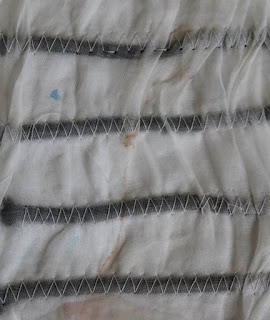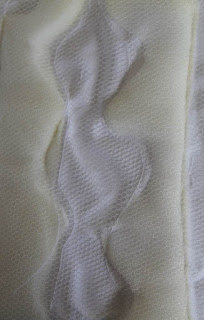Sample 1: Here I created a hand-stitched quilt mini sampler to try out a variety of hand embroidery stitches (in a linear way). My personal favourite is the chain stitch as it creates more of a texture.
 |
| 5/5/1 |
Sample 2: Another sampler of a variety of hand embroidery stitches, each focused inside the 'squares' formed by the weave pattern of the fabric. The bigger the stitch the greater the impact on this one.
 |
| 5/5/2 |
Sample 3: Instead of wadding I have tried some foam that came inside a parcel to provide protective padding. This foam is very deep- about 5cm thick but was soft and squidgy enough to work. I have used french knots to create an upholstered look to the sample. This idea could be developed further by using other components (e.g. buttons) to pull the foam in even more.
 |
| 5/5/3 |
Sample 4: 'Trapunto' style quilting. I stitched a random shape and then stuffed it from behind. Although the shape had no thought behind it (I said it was random!) it is a little reminiscent of the leaves I photographed for chapter 1. It would be easy to variate this technique with different stitches and shapes.
 |
| 5/5/4 |
Sample 5: Simple parallel quilting using a sewing machine. Here I chose a fabric with a woven stripe effect and have exaggerated this texture by sewing between the raised stripe in the fabric.
 |
| 5/5/5 |
Sample 6: Here I have used a shiny satin fabric (a thin polyester lining material). A diamond shaped quilting pattern helps to enhance the light and shade effect created.There is an optical illusion here through the photo- it looks like an inverted 'waffle' effect but in real life the surface is raised/3D as if lots of mini cushions have been joined together.
 |
| 5/5/6 |
Sample 7: A 'square' spiral. Some experimentation in how close the lines are together. The closer the lines the less 'quilted' or 'bumpy' an effect is achieved- in other words a flatter result is created. That said, the stitching gives an interesting texture to the smooth and shiny fabric. Food for thought!
 |
| 5/5/7 |
Sample 8: A chequered style pattern. The sheen on the fabric enhances the effect. I was not particularly careful with the spacing between my lines. there is further scope here to push the boundaries and use parallel lines without having to create a grid effect....
 |
| 5/5/8 |
Sample 9: Use of a wavy style machine stitch in a crisscross pattern giving the illusion of tessellations. The dullness of the chiffon fabric used mutes the quilted effect.
 |
| 5/5/9 |
Sample 10: Random 'helix' style shapes have been created here using a sewing machine on a zigzag stitch.
 |
| 5/5/10 |
Sample 11: A mini linear quilted sample using a range of decorative machine stitches. The denser the stitch pattern the more texture is achieved on the surface. The wavy stitch patterns give a more 3D effect.
 |
| 5/5/11 |
Sample 12: Use of a machine zigzag stitch with random wavy shapes created on the fabric surface. This pattern would suit larger scale panels. The pattern, combined with the brushed cotton fabric, make this sample feel very soft. I discovered while creating this one that you have to be very careful to avoid any unexpected tucks...
 |
| 5/5/12 |
Sample 13: A sheer chiffon fabric with padded area of threads/fibres trapped on the inside. Unfortunately the photo doesn't do this sample justice, the centre in real life comes across as far more 3D and has a lot more interest with the shadows created by the overlapping fibres.
 |
| 5/5/13 |
Sample 14: Strips of the packaging material foam (used in sample 3) that have been cut up and encapsulated with zigzag stitching and non woven 'net' style fabric. The matte surface of the foam contrasts really nicely with the shine of the net fabric. The stitching is directly on the foam. I was surprised at how much the stitching was able to flatten this foam.
 |
| 5/5/14 |
Sample 15: Old shoe lace used to create a cord quilt effect. I have used a piece of silk screen mesh on top. The mesh had a fierce kink in it making it difficult to keep in place when sewing.
 |
| 5/5/15 |
Sample 16: The packaging foam again but this time it has been 'side' sliced thinly (so that it is only 1 cm thick) before being used. The natural wave pattern in the foam has been exposed as a result. It has been encapsulated under nylon netting. The cotton fabric backing has crumpled up during the process adding further texture to the sample. I quite like the fact that the foam has a slight sparkle to it under lights, not something that is showing up in any photos I take though.
 |
| 5/5/16 |
































No comments:
Post a Comment